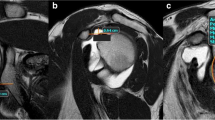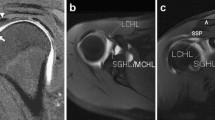Abstract
Objectives
To compare the rotator interval and capsular dimension as measured on MR arthrography between patients with clinically diagnosed multidirectional instability (MDI) and control subjects with no instability.
Materials and methods
We retrospectively reviewed a consecutive series of 658 shoulders that had undergone MR arthrography between 2006 and 2010. Of these, 97 shoulders were included in the present study. These shoulders were divided into two groups according to the clinically established diagnoses. The MDI group comprised 47 shoulders with atraumatic multidirectional shoulder instability, and the control group comprised 50 shoulders with no instability. Two independent observers measured the width and depth of the rotator interval, and the capsular dimensions at the anterior, anteroinferior, inferior, posteroinferior, and posterior regions in the two groups using MR arthrography.
Results
The rotator interval width and depth were significantly greater in the MDI group (width, observer 1, 17.7 mm, observer 2, 17.9 mm; depth, observer 1, 8.9 mm, observer 2, 8.8 mm) than in the control group (width, observer 1, 14.3 mm, observer 2, 14.5 mm; depth, observer 1, 5.9 mm, observer 2, 6.2 mm) (p < .001). The capsular dimensions at the inferior and posteroinferior regions were significantly larger in the MDI group (inferior, observer 1, 27.9 mm, observer 2, 27.8 mm; posteroinferior, observer 1, 27.0 mm, observer 2, 27.1 mm) than in the control group (inferior, observer 1, 25.7 mm, observer 2, 25.3 mm; posteroinferior, observer 1, 23.3 mm, observer 2, 23.6 mm) (p < .05). A width greater than 15.2 mm or a depth greater than 6.4 mm of the rotator interval, suggesting MDI, had sensitivities of 81 and 92 % for observer 1, and 79 and 94 % for observer 2, and specificities of 66 and 72 % for observer 1, and 62 and 66 % for observer 2, respectively.
Conclusions
Measurements of the rotator interval and the size of the distended inferior and posteroinferior joint capsule on MR arthrography are greater in shoulders with clinical MDI than in stable shoulders.




Similar content being viewed by others
References
Bak K, Spring BJ, Henderson JP. Inferior capsular shift procedure in athletes with multidirectional instability based on isolated capsular and ligamentous redundancy. Am J Sports Med. 2000;28:466–71.
Flatow EL, Miniaci A, Evans PJ, Simonian PT, Warren RF. Instability of the shoulder: complex problems and failed repairs: Part II. Failed repairs. Instr Course Lect. 1998;47:113–25.
Neer 2nd CS. Involuntary inferior and multidirectional instability of the shoulder: etiology, recognition, and treatment. Instr Course Lect. 1985;34:232–8.
Neer 2nd CS, Foster CR. Inferior capsular shift for involuntary inferior and multidirectional instability of the shoulder. A preliminary report. J Bone Joint Surg Am. 1980;62:897–908.
Johnson SM, Robinson CM. Shoulder instability in patients with joint hyperlaxity. J Bone Joint Surg Am. 2010;92:1545–57.
Levine WN, Prickett WD, Prymka M, Yamaguchi K. Treatment of the athlete with multidirectional shoulder instability. Orthop Clin North Am. 2001;32:475–84.
Pollock RG, Owens JM, Flatow EL, Bigliani LU. Operative results of the inferior capsular shift procedure for multidirectional instability of the shoulder. J Bone Joint Surg Am. 2000;82-A:919–28.
Antoniou J, Duckworth DT, Harryman 2nd DT. Capsulolabral augmentation for the management of posteroinferior instability of the shoulder. J Bone Joint Surg Am. 2000;82:1220–30.
Inui H, Sugamoto K, Miyamoto T, et al. Glenoid shape in atraumatic posterior instability of the shoulder. Clin Orthop Relat Res. 2002;403:87–92.
Kim SH, Noh KC, Park JS, Ryu BD, Oh I. Loss of chondrolabral containment of the glenohumeral joint in atraumatic posteroinferior multidirectional instability. J Bone Joint Surg Am. 2005;87:92–8.
Field LD, Warren RF, O'Brien SJ, Altchek DW, Wickiewicz TL. Isolated closure of rotator interval defects for shoulder instability. Am J Sports Med. 1995;23:557–63.
Sekiya JK. Arthroscopic labral repair and capsular shift of the glenohumeral joint: technical pearls for a multiple pleated plication through a single working portal. Arthroscopy. 2005;21:766.
Marquardt B, Potzl W, Witt KA, Steinbeck J. A modified capsular shift for atraumatic anterior-inferior shoulder instability. Am J Sports Med. 2005;33:1011–5.
Hamada K, Fukuda H, Nakajima T, Yamada N. The inferior capsular shift operation for instability of the shoulder. Long-term results in 34 shoulders. J Bone Joint Surg Br. 1999;81:218–25.
Joseph TA, Williams Jr JS, Brems JJ. Laser capsulorrhaphy for multidirectional instability of the shoulder. An outcomes study and proposed classification system. Am J Sports Med. 2003;31:26–35.
Ovesen J, Nielsen S. Stability of the shoulder joint. Cadaver study of stabilizing structures. Acta Orthop Scand. 1985;56:149–51.
Ovesen J, Nielsen S. Posterior instability of the shoulder. A cadaver study. Acta Orthop Scand. 1986;57:436–9.
Ovesen J, Nielsen S. Experimental distal subluxation in the glenohumeral joint. Arch Orthop Trauma Surg. 1985;104:78–81.
Jost B, Koch PP, Gerber C. Anatomy and functional aspects of the rotator interval. J Shoulder Elbow Surg. 2000;9:336–41.
Dewing CB, McCormick F, Bell SJ, et al. An analysis of capsular area in patients with anterior, posterior, and multidirectional shoulder instability. Am J Sports Med. 2008;36:515–22.
Hsu YC, Pan RY, Shih YY, Lee MS, Huang GS. Superior-capsular elongation and its significance in atraumatic posteroinferior multidirectional shoulder instability in magnetic resonance arthrography. Acta Radiol. 2010;51:302–8.
Kim KC, Rhee KJ, Shin HD, Kim YM. Estimating the dimensions of the rotator interval with use of magnetic resonance arthrography. J Bone Joint Surg Am. 2007;89:2450–5.
Ng AW, Chu CM, Lo WN, Lai YM, Kam CK. Assessment of capsular laxity in patients with recurrent anterior shoulder dislocation using MRI. Am J Roentgenol. 2009;192:1690–5.
Zlatkin MB, Bjorkengren AG, Gylys-Morin V, Resnick D, Sartoris DJ. Cross-sectional imaging of the capsular mechanism of the glenohumeral joint. Am J Roentgenol. 1988;150:151–8.
Harryman 2nd DT, Sidles JA, Harris SL, Matsen 3rd FA. The role of the rotator interval capsule in passive motion and stability of the shoulder. J Bone Joint Surg Am. 1992;74:53–66.
Helmig P, Sojbjerg JO, Kjaersgaard-Andersen P, Nielsen S, Ovesen J. Distal humeral migration as a component of multidirectional shoulder instability. An anatomical study in autopsy specimens. Clin Orthop Relat Res. 1990;252:139–43.
An YH, Friedman RJ. Multidirectional instability of the glenohumeral joint. Orthop Clin North Am. 2000;31:275–85.
Shafer BL, Mihata T, McGarry MH, Tibone JE, Lee TQ. Effects of capsular plication and rotator interval closure in simulated multidirectional shoulder instability. J Bone Joint Surg Am. 2008;90:136–44.
Chechik O, Maman E, Dolkart O, Khashan M, Shabtai L, Mozes G. Arthroscopic rotator interval closure in shoulder instability repair: a retrospective study. J Shoulder Elbow Surg. 2010;19:1056–62.
Provencher MT, Dewing CB, Bell SJ, et al. An analysis of the rotator interval in patients with anterior, posterior, and multidirectional shoulder instability. Arthroscopy. 2008;24:921–9.
Acknowledgments
This work was supported by Konkuk University in 2012.
Author information
Authors and Affiliations
Corresponding author
Rights and permissions
About this article
Cite this article
Lee, H.J., Kim, N.R., Moon, S.G. et al. Multidirectional instability of the shoulder: rotator interval dimension and capsular laxity evaluation using MR arthrography. Skeletal Radiol 42, 231–238 (2013). https://doi.org/10.1007/s00256-012-1441-2
Received:
Revised:
Accepted:
Published:
Issue Date:
DOI: https://doi.org/10.1007/s00256-012-1441-2




